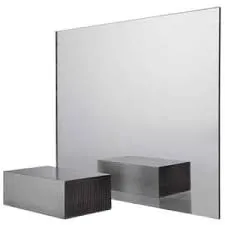

The Fascinating World of Translucent Mirror Glass
Translucent mirror glass, often referred to simply as one-way mirror or two-way mirror, is an intriguing material that blends the properties of glass and a reflective surface, allowing for a unique application in various fields. This specialized glass is not only functional but also adds an aesthetic appeal to spaces and products, making it a popular choice in architecture, art, and technology.
At first glance, translucent mirror glass appears to be an ordinary mirror, reflecting images and light. However, its true magic lies in its dual functionality. When illuminated from one side, it operates like a mirror, while on the opposite side, it becomes partially transparent, allowing one to see through it. This peculiar characteristic makes it invaluable in a variety of applications, from surveillance and security to elegance in interior design.
One of the most common applications of translucent mirror glass is in the field of security and surveillance. For instance, this glass is often utilized in police interrogation rooms and interrogation mirrors, allowing officers to discreetly observe suspects while remaining unseen. The effective use of this material enhances security measures without compromising the psychological aspect of the interrogation process. Similarly, it is found in retail environments, where store owners can monitor shoppers’ behavior without being intrusive, thus creating a more comfortable shopping experience.
In addition to security applications, translucent mirror glass has gained prominence in architectural design
. Its reflective properties serve to create stunning visual effects in buildings. For example, this glass is often used in facades, where it can reflect the surrounding environment, blending structures seamlessly into their surroundings. This aspect contributes not only to energy efficiency by reducing the need for artificial lighting but also to aesthetic appeal, yielding a modern and sleek appearance.
Furthermore, translucent mirror glass has found its way into the artistic domain. Artists and designers have begun to embrace this material for its ability to challenge perceptions and manipulate light. Installations utilizing such glass can create immersive experiences, engaging viewers by distorting reality or providing layered visuals. These artistic applications highlight the versatility of translucent mirror glass, transforming ordinary space into something extraordinary.
In a more practical context, translucent mirror glass is also used in technology. Its applications in display screens, for instance, provide manufacturers with the ability to create sophisticated devices that balance functionality with an engaging user interface. Emerging technologies have exploited this material to create interactive screens that can switch between display and transparency, enhancing user experience in various consumer electronics.
Despite its many benefits, working with translucent mirror glass requires careful consideration during production and installation. The thickness of the glass, the quality of the reflective coating, and the lighting conditions of the space all play crucial roles in determining the glass’s effectiveness. It is essential to ensure that the application is suited to the specific needs, whether for security, design, or technological use.
In conclusion, translucent mirror glass stands out as a remarkable material that bridges the gap between functionality and artistry. Its ability to provide privacy while offering visibility, coupled with its sleek aesthetic, makes it an invaluable resource in various sectors. As technology continues to advance and design trends evolve, the significance of translucent mirror glass will likely grow, inspiring further innovation and creativity. Whether in enhancing security, beautifying buildings, or enriching artistic expression, this unique glass remains a fascinating subject in contemporary discourse.